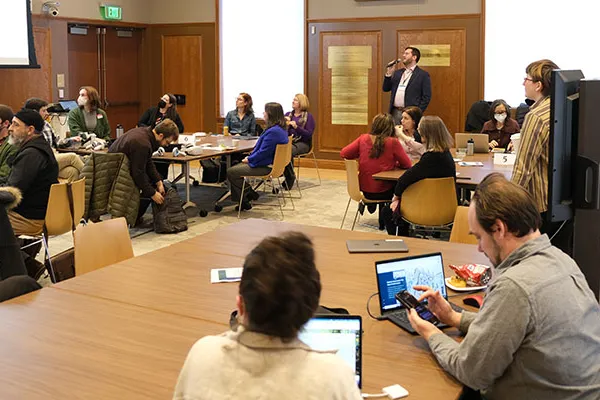2022 Digital Pedagogy Fellowship Recipients Showcase Digital Student Scholarship
News

Published March 2, 2023
Faculty recipients of the 2022 Digital Pedagogy Fellowship presented digital scholarship projects they have been developing during fall semester at a recent Sherrerd Center Teaching Arts Lunch. The fellowship program partners faculty with staff from the Libraries’ and ITS Learning, Research & Technology team to receive hands-on training in digital innovation spaces in Neilson Library, build their digital fluency, and engage in a community of practice with other faculty. Scholarship projects ranged from interactive maps & data visualizations, short form podcasts, infographics and web design, digital storytelling, and a virtual reality field trip. See the recent project showcase.
The Digital Pedagogy Fellowship is funded by ITS.
2022 Fellowship Recipients
Kelly Anderson, Study of Women & Gender and Archives
Students in Intro to Women and Gender Studies (SWG 150), were asked to create 6-8 minute podcasts about the Dobbs decision and the post-Roe landscape using materials from Smith’s archival sources. Students worked with ITS staff to learn about producing podcast episodes.
Joshua Birk, History
Members of the Medieval History Lab worked with the Spatial Analysis Lab (SAL) to visualize large, primary source data sets using ArcGIS and Storymaps. Students felt empowered to design their own projects and create visualizations that are accessible to non-specialists.
Lucretia Knapp, Art
Students in ARS 263, Video and Time-Based Digital Media, experimented with modes of audio and video production and worked with ITS staff to explore the media production spaces in the Digital Media Hub in Neilson Library and Alumnae Gym.
Miranda McCarvel, English & Education
Students in Linguistics for Educators (EDC 212) created infographics for new K-12 teachers to better understand linguistic issues in the classroom. Working with ITS staff, students learned about graphic design principles and software for design projects.
Kathleen Pierce, Art
Students in the Imperial Design colloquium (ARH 291) explored decorative arts at the Smith College Museum of Art through creating Storymaps in partnership with the Spatial Analysis Lab (SAL). Projects explore how objects move through systems of trade, politics, identity, and power.
Jonathan Ruseski, Jacobson Center & English
Students in the Art of the Steal (ENG 118) explored the remix as a tool for social critique and cultural transformation. Working with ITS staff and resources in the Digital Media Hub, students created digital multimedia remixes responding to other words of art in a media of their choosing.
Maria Succi-Hempstead, Italian Studies
Students in Intermediate Italian Conversation (ITL 235) conducted independent research projects in the Smith College Archives about the history of Italian instruction at the college and in Florence. Working with ITS staff, students created video presentations about their research.
L.M. Ward, Geosciences
In partnership with the Spatial Analysis Lab (SAL) and the Imaging Center, Luce Ward and Greg de Wet developed a pilot virtual reality geology field trip based on the Holyoke Dinosaur Footprints. The pilot project was tested with approximately 50 students in GEO 102 using VR headsets.
Lynne Yamamoto, Art
In Projects in Installation (ARS 274), students planned installation pieces and reflected on the physical characteristics, histories, present use, and communities of a particular site. The class worked with the Spatial Analysis Lab (SAL) to visualize information layers about the zip codes of their hometowns using ArcGIS.
Alexis Ziemba, Neuroscience
Students practiced distilling complex clinical information to create video presentations (FYS 106) and patient-facing websites (NSC 316) on topics including Alzheimer’s Disease, brain tumors, and traumatic spinal cord injury in partnership with ITS and Libraries staff.

Andrew Maurer, Interactive Media Coordinator at the Smith College Imaging Center, discussing the process of developing a virtual reality geology field trip based on the Holyoke Dinosaur Footprints in partnership with Luce Ward and Greg de Wet from Geosciences.
Contact
Travis Grandy
tgrandy@smith.edu